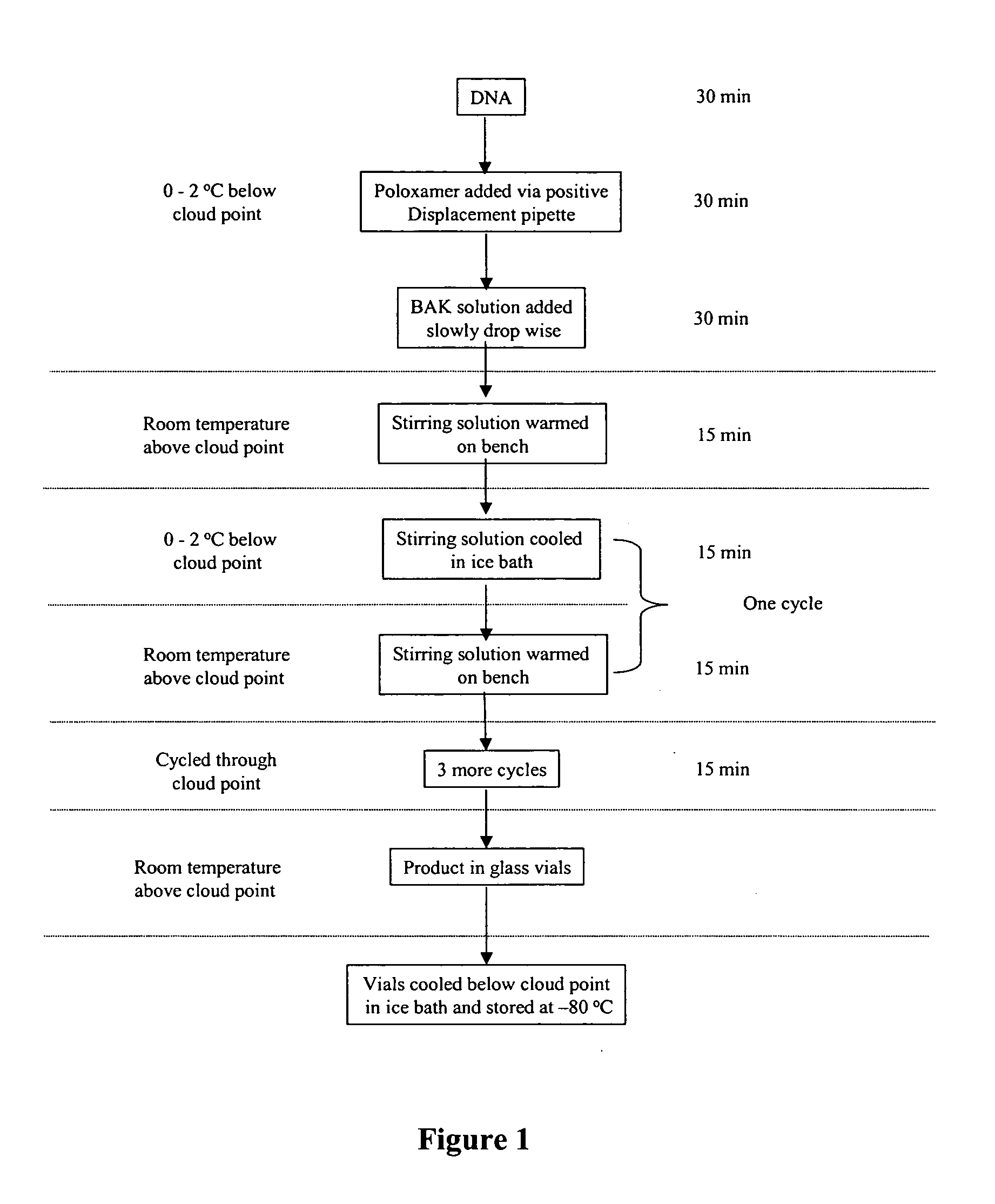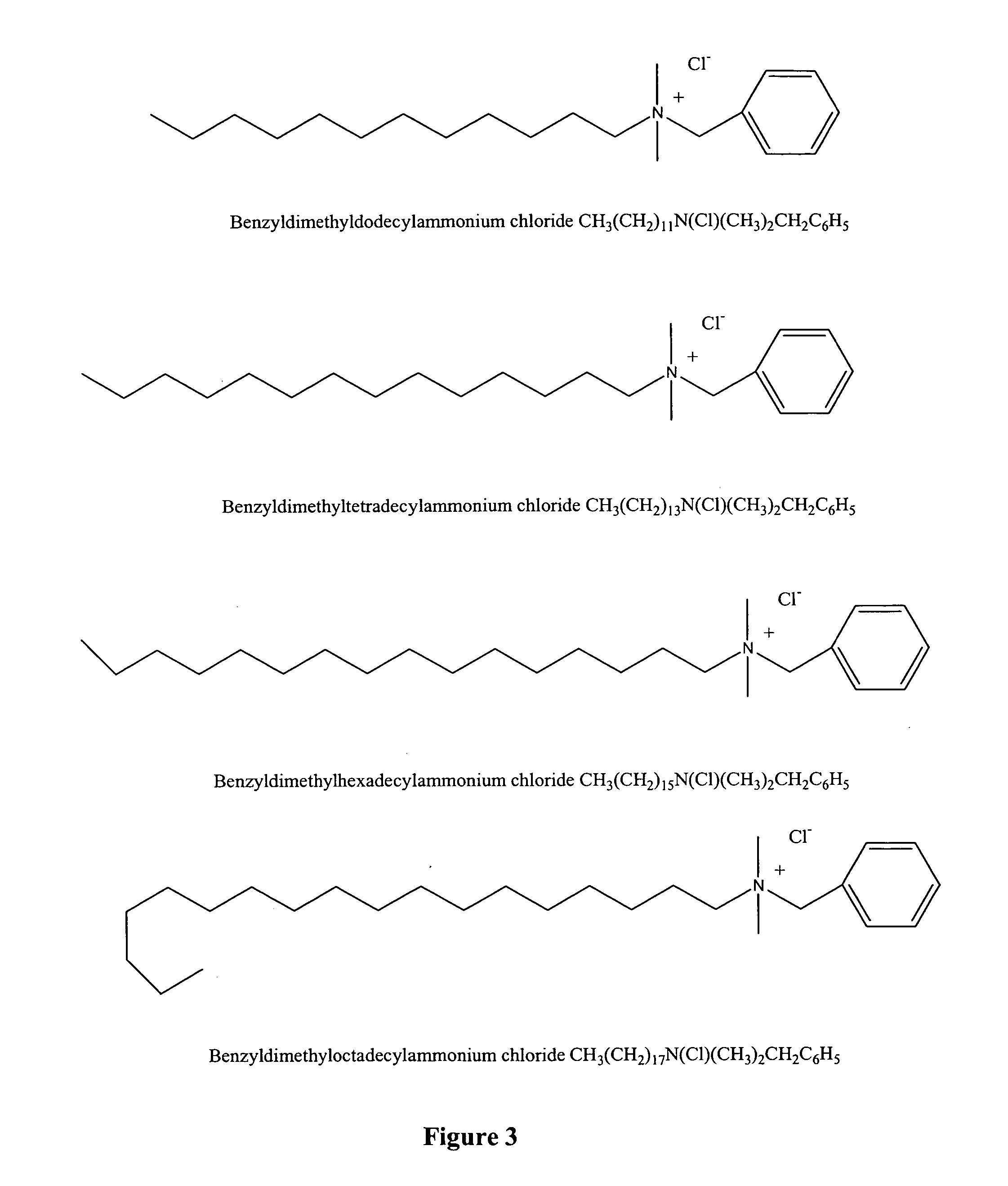Methods for producing block copolymer/amphiphilic particles
a technology of amphiphilic particles and copolymers, which is applied in the direction of capsule delivery, drug compositions, nanocapsules, etc., can solve the problems of increasing the cost of large-scale production, affecting the ability to scale up the production of this formulation for commercial manufacturing, and affecting the immune response. , to achieve the effect of enhancing or generating an immune respons
- Summary
- Abstract
- Description
- Claims
- Application Information
AI Technical Summary
Benefits of technology
Problems solved by technology
Method used
Image
Examples
example 1
Formation of Cell Delivery Particles Using Thermal Cycling Method
[0215] This example describes the interactions of poloxamer CRL-1005 and DNA with BAK C12, BAK C14, BAK C16 and BAK C18 to form cell delivery particles using the thermal cycling methods described in U.S. Published Patent Applications 2004 / 0162256 A1 and 2004 / 0209241 A1.
[0216] Stock solutions of benzyldimethyldodecylammonium chloride (BAK C12, Fluka Chemical Corp., Milwaukee, Wis., cat #53233), benzyldimethyltetradecylammonium chloride (BAK C14, TCI America, Portland, Oreg., cat #A0208), benzyldimethylhexadecyllammonium chloride (BAK C16, TCI America, Portland, Oreg., cat #B0237) and benzyldimethyloctadecylammonium chloride (BAK C18, TCI America, Portland, Oreg., cat #B1297) were made in PBS. The solubility of BAK C12, C14 and C16 at 25° C. and 45° C. were recorded. See Table 2.
TABLE 2Dissolution characteristics of BAK homologsConcentration inDissolutionPrecipitates atHomologPBS (mM)Temperature (° C.)25° C.?C14525N...
example 2
[0248] The following example describes the change in particle size and surface charge when poloxamer solutions with or without cationic lipids are subject to high pressure homogenization.
[0249] Particles of poloxamers CRL-8300 and CRL-1005 at a concentration of 7.5 mg / ml each in PBS (30 ml) were prepared by homogenization in an EmulsiFlex-C50 high pressure homogenizer at 15,000 psi and 15° C. The particles were collected in a 50 ml conical tube after 10 passes through the adjustable homogenizing valve. The size of the particles produced was determined using photon correlation spectroscopy (See Table 9) and the surface charge of the particles was also determined using micro-electrophoresis. See Table 10.
TABLE 9Particle size nmParticle size nm(Polydispersity)(Polydispersity)Solutionbefore homogenizationafter homogenizationCRL-8300 @ 7.5 mg / ml2,353 (0.84)200 (0.23)in PBSCRL-1005 @ 7.5 mg / ml1,752 (0.25)228 (0.4) in PBS
[0250]
TABLE 10Surface charge mVSurface charge mVSolutionbefore hom...
example 3
[0253] This example describes the change in particle size and surface charge when poloxamer and DMRIE solutions are subject to high pressure homogenization. The change in particle size and surface charge of the homogenized particles after the addition of DNA is also described
[0254] Stock solutions of 15 mg / ml CRL-8300 in 2× PBS and 0.2 or 2.0 mM DMRIE in sterile water for injection were made. 15 ml of the poloxamer solution and 15 ml of the 0.2 mM lipid solution were then mixed in a 50 ml conical tube by gentle inversion at room temperature. The size of the particles produced was determined using photon correlation spectroscopy and the surface charge of the particles was also determined using micro-electrophoresis. See Table 12.
[0255] The solution was then homogenized in an EmulsiFlex-C50 high pressure homogenizer at 15,000 psi and 15° C. for 10 passes through the adjustable homogenizing valve and collected in a 50 ml conical tube. The size of the particles produced was determined...
PUM
| Property | Measurement | Unit |
|---|---|---|
| Temperature | aaaaa | aaaaa |
| Temperature | aaaaa | aaaaa |
| Temperature | aaaaa | aaaaa |
Abstract
Description
Claims
Application Information
 Login to View More
Login to View More - R&D
- Intellectual Property
- Life Sciences
- Materials
- Tech Scout
- Unparalleled Data Quality
- Higher Quality Content
- 60% Fewer Hallucinations
Browse by: Latest US Patents, China's latest patents, Technical Efficacy Thesaurus, Application Domain, Technology Topic, Popular Technical Reports.
© 2025 PatSnap. All rights reserved.Legal|Privacy policy|Modern Slavery Act Transparency Statement|Sitemap|About US| Contact US: help@patsnap.com



